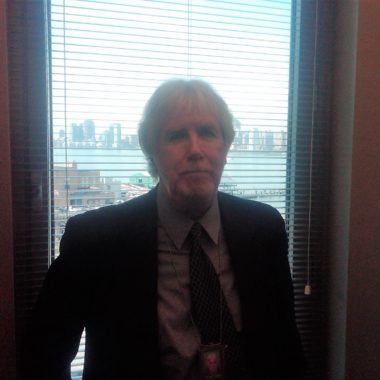I’m not a big theater fan. I’d rather see a flick. No need to change out of flip-flops, plenty of legroom, no lines at the urinal, and somewhat affordable. On the other hand, my wife grew up in rural Illinois, but as a kid her parents took her to Broadway to see My Fair Lady. Thus was a theater buff born. So I get dragged to a lot of shows, sometimes willingly (Stephen Sondheim, Tom Stoppard), sometimes groaning (everything else). In the latter category, I now include a drama that ends its two-month run on December 18th, Straight Line Crazy. In July Virginia ordered two nosebleed seats for $500 and by the time of our Thanksgiving-Eve arrival, tickets were being resold for over a thousand bucks. Each. Ralph Fiennes as Robert Moses proved to be as big a draw as Taylor Swift. Who knew? And why is “Ralph” pronounced “Rafe”?
We saw the play at a new theater in the new Hudson Yards, located at the top of a six-story escalator ride in a new arts-only building called The Shed. There’s a bar in the lobby where you can grab a shot of booze for $17 if you can wait a half hour to get served. Otherwise, forget it. To get there from Flatbush, we took the B train to Bryant Park (renovated by Robert Moses in 1934), walked through a block-long tunnel to the 5th Avenue stop of the #7 train which took us to the new Hudson Yards station located four escalators (125 feet) below the street, making it our new go-to bunker, assuming we have an hour before bombs-away-baby. Still, a new surface-level cross-town rail would have been a welcome alternative. If only Robert Moses had built some.
The play’s title derives from urbanologist Jane Jacobs’ characterization of the planning method used by the Great Master Builder: draw the shortest distance between two points no matter the human toll. Early on, when the Jacobs character first appears by breaking the fourth wall to announce herself to the audience, there was enthusiastic applause. I asked Virginia whether the actress was famous. “No,” she whispered, “now be quiet!”
I’m told the audience has cheered the Jacobs entry at every performance because hipsters know she’s the female David who defeated the Gotham Goliath. And by the time of her death in 2006 at the age of 90, bicycling Jane had become a patron saint of the “Reclaim Our Streets from Evil Autos” movement. In 1973, when Robert Caro handed in the massive manuscript for his Moses biography, The Power Broker, he was told it was a million words too long. WTF! He reluctantly cut out his long chapter on Jane Jacobs so that her name does not even appear in the seminal work that instantly transformed the consensus estimation of Robert Moses: from an admirable get-things-done public servant colossus to a neighborhood-destroying racist who, for better and for worse, fully shaped the world we New Yorkers have inhabited for the past sixty years. A world with problems Moses created by refusing to build any mass transit infrastructure that would have made his incredible transportation achievements sustainable. Indeed Caro’s subtitle for his 1,250-page magnum opus was “Robert Moses and the Fall of New York.”
By the way, my paperback Power Broker weighs in at 3.5 pounds, more than my laptop. Hell, my hardcover Bible checks in at only 992 pages and is a lightweight one-pounder by comparison. Two copies of The Power Broker work very well as handheld dumbbells for building arm strength. In addition, the Big Apple’s greatest living historian, Columbia University’s Kenneth T. Jackson, still considers it the single most important book written about 20th Century New York.
Moses created most of the parks, pools, highways, and bridges we use today, carving up parts of the outer boroughs in the process. In Brooklyn alone, he gave us the Verrazano and Gil Hodges bridges, the Battery Tunnel, huge municipal pools, Manhattan Beach, dozens of playgrounds, the Red Hook Recreation Center, Prospect Park Zoo, Marine Park, McCarren Park, Canarsie Beach Park, Spring Creek Park, and the Jackie Robinson Parkway. But he also scarred and divided Sunset Park, South Brooklyn, Windsor Terrace, with his Gowanus, Brooklyn-Queens, and Prospect Expressways.
Then, just as he was about to rip straight-line gashes through Manhattan with east-west expressways and extend 5th Avenue through Washington Square Park, he was defeated. The Village projects in particular proved a bridge too far, thanks to the community’s effective opposition, bolstered by Jacobs’ influential 1961 book, The Death and Life of Great American Cities. The birth of that opposition in 1956 served as the denouement of the play.
Straight Line Crazy is structured by British playwright David Hare as a tragedy. Moses out-maneuvers filthy rich upper-class resistance in Act One by leveraging the political muscle of a popular Governor (Al Smith) to build expressways for a rising tide of middle-class motorists drawn to his new parks and beaches on Long Island. By Act Two, he has simply ignored the powerless lower-class to bulldoze his way through the Bronx, displacing thousands of residents, calling it urban renewal. But the mover-and-shaker was stopped dead in his tracks by the organized middle class of Greenwich Village. Hare’s dialogue zeros in on the Master Builder’s racism, driving it home so to speak by inventing a Black female foil from the South Bronx on Moses’ staff. He never built a promised railroad spur to Jones Beach, and dismissed any thoughts of new subway construction. His automobile-centric planning at the expense of mass transit provided cover for the racism that explains why, in the 1930s, he built two playgrounds for Black children and 253 for whites. But he was ultimately humbled by activists who didn’t want to sacrifice their homes, their park, and their neighborhood on the Moses altar of improved traffic flow. Oh, Moses, how blind and haughty thou be! Meh. You didn’t miss much, except for Ralph Fiennes proving he can still add nuance to the monsters he plays, be it the unhinged Nazi commandant of Schindler’s List or Voldemort in the Harry Potter series. Read Caro and Jacobs instead and you’ll find Moses was first stymied by Brooklyn Heights activists in 1954.
Moses died in 1981 at the age of 93, a very flawed man who did some great things but hurt thousands of people and bequeathed us huge transit deserts. As for Jane Jacobs, in 1969 she relocated her family to Toronto to spare her sons from the Vietnam-era draft. As fate would have it, the house where they moved was on another straight line drawn for that city’s new Spadina Expressway. Uh oh. This is the part where we came in. I sure hope they add that vignette when they make the movie.
Well, time to kick back, pour myself a Dewars and savor the Pogues & Kristy McColl goin’ at it again in my favorite Christmas classic, “Fairytale of New York.” Peace on Earth and God Bless Ukraine.











One Comment
Just to be clear, it was Moses’ most ardent supporter, Iphigene Ochs Sulzberger, wife of the NY Times publisher, who told Caro, “Engineers are straight-line crazy.” Hare had Jane Jacobs say the line which I’m sure Jacobs would have been proud to own.